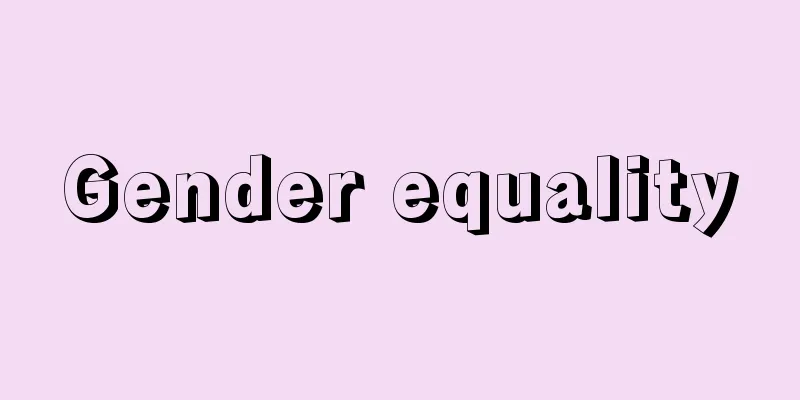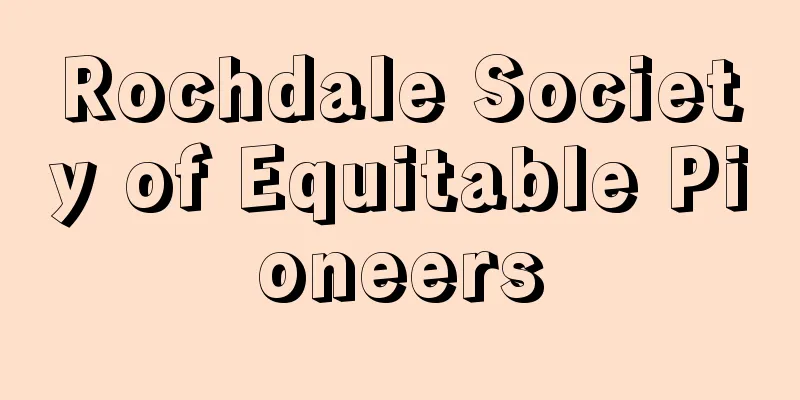Gender equality

|
It refers to a state in which men and women are economically, politically, socially, and culturally equal, and each is an independent individual. It also refers to the idea that such a state is desirable. The background to the claim for gender equality is the reality that there is inequality between men and women, and that women are discriminated against. [Akiko Fuse] Thought developmentThe idea of gender equality emerged during the historical period of change from the latter half of the 18th century onwards. Behind this was the reality that women, who had fought alongside men in the French Revolution and the American War of Independence, had to accept political and social inequality after the Revolution and the American War of Independence, and that women were forced to work in cheap and unstable conditions while being strongly attracted to large-scale mechanized industry after the Industrial Revolution, a typical development in England. For example, M. Wollstonecraft, a pioneer of British women's liberation thought, argued that women could not have personal independence without economic independence based on an education in reason (A Vindication of the Rights of Woman, 1792). Similarly, British economist J. S. Mill advocated for women's suffrage, mainly in parliament (The Serfdom of Women, 1869). German thinker K. Marx argued that "the degree of social progress can be accurately measured by the social status of the beautiful sex," and revealed the actual situation of female workers during the period of primitive accumulation of capitalism (Das Kapital, Vol. 1, 1867). In addition, F. Engels, who founded scientific socialism together with Marx, traced the origin of inequality between men and women to the establishment of a private property system, and developed a theory that the return of women to social industry in capitalist society would create the material conditions for gender equality (The Origin of the Family, Private Property and the State, 1884). Lenin, the leader of the Russian Revolution, concretely clarified the path to gender equality in the first socialist country in history. However, the oppression of women by men, which was the basis of this theory of women's liberation, was considered to be caused by the existence of a class society based on private property. The discourse that the relationship between oppressors and the oppressed would also be eliminated if class society were abolished was forced to reconsider its theoretical considerations as the realities of male-female relations in countries that advocated socialism became clear in the second half of the 20th century. [Akiko Fuse] Modern MovementThe idea of gender equality advocated in Article 1 of the Declaration on the Elimination of All Forms of Discrimination against Women, adopted by the 22nd United Nations General Assembly in 1967, states that "any discrimination against women which in practice denies or restricts their equal rights with men is fundamentally unjust and an offense against human dignity," as well as the Mexican Declaration and World Programme of Action adopted at the World Conference on the International Women's Year (First World Women's Conference) (both in 1975) and the Convention on the Elimination of All Forms of Discrimination against Women (Convention on the Elimination of All Forms of Discrimination against Women, 1979) adopted by the United Nations General Assembly, show the fruition of ideas and movements seeking gender equality since the 18th century. At the same time, they teach us that movements aimed at realizing gender equality in the true sense of the word are developing beyond individual countries and societies, centered on women who still live in conditions of economic, political, social and cultural discrimination and inequality. [Akiko Fuse] "Dictionary of Women's Issues" compiled by the Committee for the Publication of the Dictionary of Women's Issues (1980, Gakushu no Tomosha)" ▽ "International Women's Law Study Group compiled by International Women's Conventions and Resources" (1993, Toshindo) ▽ "Dictionary of Feminism" written by Lisa Tuttle and supervised by Kazuko Watanabe (1998, Akashi Shoten) [References] | | | Women| | | | |Source: Shogakukan Encyclopedia Nipponica About Encyclopedia Nipponica Information | Legend |
|
男性と女性が、経済的、政治的、社会的、文化的に平等であり、それぞれに独立した人格である状態をさす。また、そうした状態が望ましいとする思想をさす。男女平等が主張される背景には、男女間に不平等があり、女性が差別されている現実がある。 [布施晶子] 思想的展開男女平等思想は、18世紀後半以降の歴史的変革期において登場した。その背後には、フランス革命、アメリカ独立戦争を男性とともに闘ったにもかかわらず、革命後、独立後には、政治的にも社会的にも男女の不平等に甘んじざるをえなかった現実、イギリスにおいて典型的な展開をみる産業革命後の機械制大工業に激しく吸引されつつも、女性は安価で不安定な状態における酷使を強いられた現実への凝視があった。たとえば、イギリスの女性解放思想の先達M・ウルストンクラフトは、理性の教育に基づく経済的自立なくしては女性の人格の独立はないと主張した(『女性の権利の擁護』1792)。同じくイギリスの経済学者J・S・ミルは、議会を中心に女性の参政権を主張した(『女性の隷従』1869)。ドイツの思想家K・マルクスは「社会の進歩の度合いは、美しい性の社会的地位いかんによって正確に測ることができる」と説き、資本主義の原始的蓄積期における女性労働者の実態を明らかにした(『資本論 第1巻』1867)。また、マルクスとともに科学的社会主義を創始したF・エンゲルスは、男女の不平等の起源を私有財産制度の確立に求めるとともに、資本主義社会における女性の社会的産業への復帰が、男女平等の物的条件づくりをなすという理論を展開した(『家族、私有財産および国家の起原』1884)。ロシア革命の指導者レーニンは、史上初の社会主義国における男女平等の道筋を具体的に明らかにしていった。しかしながら、こうした女性解放の理論の基盤に据えられていた男性の女性に対する抑圧は、私有財産制に基づく階級社会の存在に基因するものとされていたのである。階級社会の廃絶がなされるならば、抑圧と被抑圧の関係も解消されるという言説は、20世紀後半、社会主義を掲げた国々における男女関係の実相が明らかにされるにつれ、理論的考察の見直しを迫られることになった。 [布施晶子] 現代の運動1967年、第22回国連総会で採択された「女性差別撤廃宣言」第1条「男性との権利の平等を実際上否定又は制限する女性に対する差別は、基本的に不正であり、人間の尊厳に対する侵犯である」、さらには国際婦人年世界会議(第1回世界女性会議)で採択された「メキシコ宣言」「世界行動計画」(ともに1975)、国連総会で採択された「女性に対するあらゆる形態の差別の撤廃に関する条約」(女性差別撤廃条約。1979)などがうたう男女平等の理念は、18世紀以降の男女平等を求める思想と運動の結実を示す。同時に、いまだ経済的、政治的、社会的、文化的に差別と不平等の状態にある女性を中心に、正しい意味での男女平等の実現を目ざす運動が、一国一社会を越えて展開されつつあることを教えている。 [布施晶子] 『婦人問題辞典刊行委員会編『婦人問題辞典』(1980・学習の友社)』▽『国際女性法研究会編『国際女性条約・資料集』(1993・東信堂)』▽『リサ・タトル著、渡辺和子監訳『フェミニズム事典』(1998・明石書店)』 [参照項目] | | | | | | | |出典 小学館 日本大百科全書(ニッポニカ)日本大百科全書(ニッポニカ)について 情報 | 凡例 |
<<: Tangier - Tangier (English spelling)
>>: Equal Employment Opportunity Law - danjokoyoukikaikintoho
Recommend
French - French
Like Italian, Spanish, and Romanian, French is a ...
Battle of Okehazama
A battle between Imagawa Yoshimoto and Oda Nobunag...
Pontos Euxeinos (English spelling)
...Most of the coastal areas are blessed with a m...
Mizar
Zeta star in Ursa Major. In a telescope, it is a b...
APC (political party)
...The conflict between the north and south, repr...
Compound fracture
…In the case of an open fracture, even if the wou...
open biopsy (English)
...It is mainly used to distinguish between benig...
Adoike Pond
A lagoon in the northeast of Higashikagawa City, ...
Pseudotsuga
...The family Pinaceae consists of 10 genera and ...
English Garden - English Garden
A type of landscape garden developed in England be...
Salvation - Osukui
〘Noun〙 ("o" is a prefix)① An honorific w...
Ono Jiroemon - Ono Jiroemon
→Tadaaki Ono Source: Shogakukan Encyclopedia Nipp...
ṣalāt (English spelling) salat
…It is quite reasonable to assume that the kalima...
Gray waxbill - Gray waxbill
A bird of the family Acanthidae (illustration) in ...
Eusebius Sophronius Hieronymus
Latin Church Father, Bible scholar, and saint. Hi...









